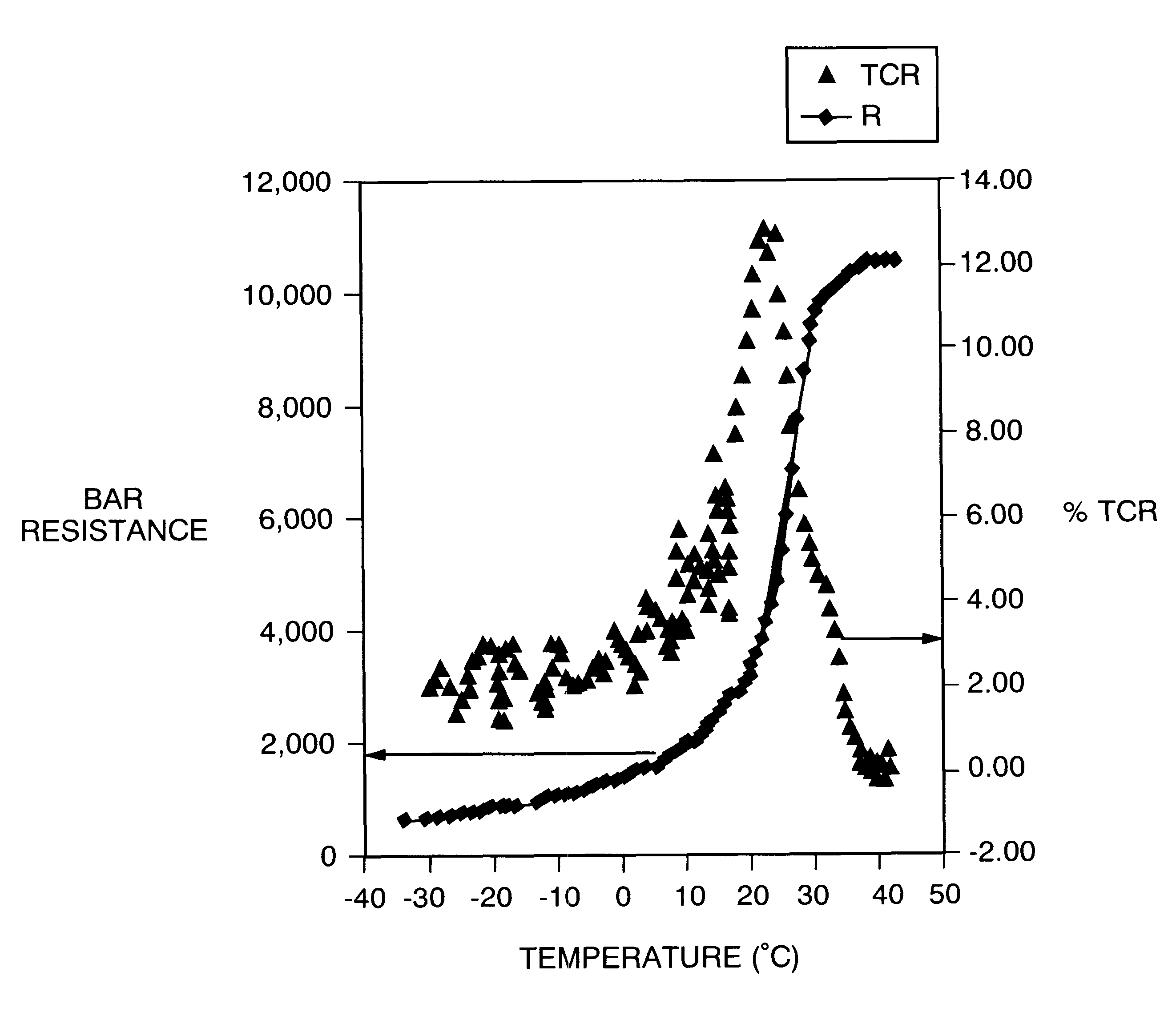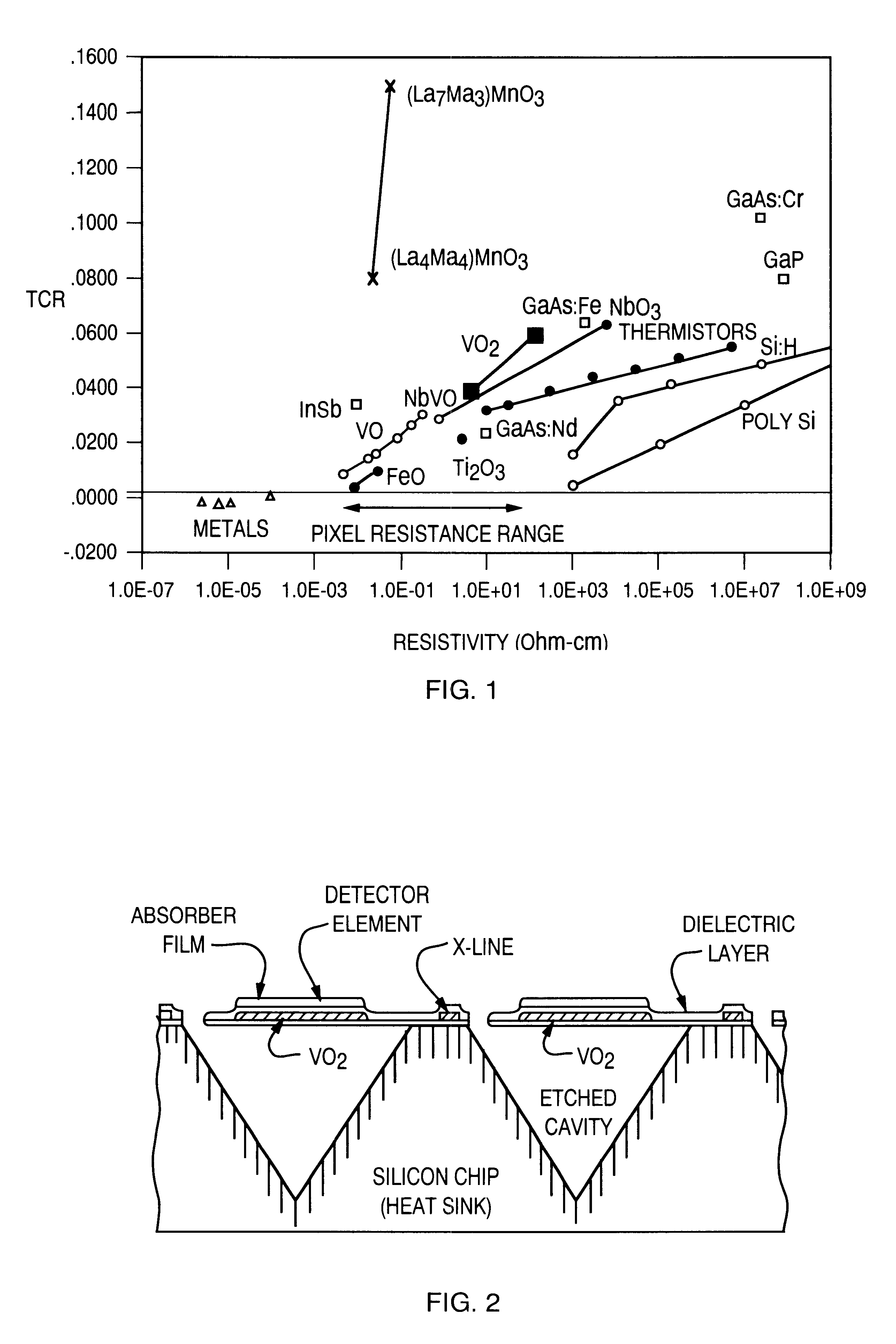Large temperature coefficient of resistance material
a resistance material and large temperature coefficient technology, applied in the field of resistor materials, can solve the problems of insignificant constancy over a wide temperature range, temperature change, and insignificant increas
- Summary
- Abstract
- Description
- Claims
- Application Information
AI Technical Summary
Problems solved by technology
Method used
Image
Examples
example 2
with nominal composition (La.sub.0.7 Pb.sub.0.3)MnO.sub.3 and (La.sub.0.7 Ca.sub.0.3)MnO.sub.3 were deposited on (100) LaAlO.sub.3 substrates with an MOCVD system under the deposition condition listed in Example 1. The resulting layers were epitaxial with the substrates. The resistivity of both layers as a function of temperature was measured by a conventional four-probe method. The (La.sub.0.7 Pb.sub.0.3)MnO.sub.3 layer showed a broad magnetic transition with a peak resistance temperature of about 350.degree. K. The TCR of the layer peaked at 295.degree. K, but was a relatively low 1.7% / .degree. C. In contrast, the (La.sub.0.7 Ca.sub.0.3)MnO.sub.3 layer showed a sharp magnetic transition with a peak temperature of about 260.degree. K. The TCR of the layer was a high 15% / .degree. C. at 240.degree. K.
example 3
tion of calcium and lead in substitution for lanthanum showed a trade-off between transition temperature and the TCR characteristic. FIG. 5 shows the resistance as a function of temperature for (La.sub.0.6 Ca.sub.0.3 Pb.sub.0.1)MnO.sub.3 and (La.sub.0.6 Ca.sub.0.2 Pb.sub.0.2)MnO3 layers deposited on (100) LaAlO.sub.3 substrates by MOCVD under the deposition conditions as listed in Example 1. The film with a composition (La.sub.0.6 Ca.sub.0.3 Pb.sub.0.1)MnO.sub.3 had a TCR=12% / .degree. C. at 263.degree. K, 10% / .degree. C. at 273.degree. K, and 7% / .degree. C. at 278.degree. K while the film with a composition (La.sub.0.6 Ca.sub.0.2 Pb.sub.0.2)MnO.sub.3 had a TCR=5.6% / .degree. C. at 263.degree. K, 6.4% / .degree. C. at 273.degree. K and 6% / .degree. C. at 278.degree. K.
example 4
ystal substrates of (100) yttrium stabilized zirconia (YSZ) were provided. (La.sub.0.6 Ca.sub.0.3 Pb.sub.0.1)MnO.sub.3 films were deposited on bare YSZ, CeO.sub.2 buffered YSZ, Yba.sub.2 Cu3O.sub.7 (YBCO) deposited on CeO.sub.2 buffered YSZ, and YBCO buffered YSZ substrates under the same deposition conditions listed in Example 1. Both the YBCO and CeO.sub.2 layers were also deposited in the same CVD chamber and under the same conditions listed in Example 1 used for deposition of the (La.sub.0.6 Ca.sub.0.3 Pb.sub.0.1)MnO.sub.3 films. 2% cobalt was doped into the YBCO layer to increase its resistivity. FIGS. 6A and 6B (wherein (La.sub.0.6 Ca.sub.0.3 Pb.sub.0.1)MnO.sub.3 is designated by LPCMO) show that the film directly deposited on the YSZ substrate was (110) oriented and had a very broad magnetic phase transition at 223.degree. K and thus a low TCR characteristic. However, the film deposited on the CeO.sub.2 buffer layer on YSZ has a mixed orientation of (100) and (110) and a much...
PUM
 Login to View More
Login to View More Abstract
Description
Claims
Application Information
 Login to View More
Login to View More - R&D
- Intellectual Property
- Life Sciences
- Materials
- Tech Scout
- Unparalleled Data Quality
- Higher Quality Content
- 60% Fewer Hallucinations
Browse by: Latest US Patents, China's latest patents, Technical Efficacy Thesaurus, Application Domain, Technology Topic, Popular Technical Reports.
© 2025 PatSnap. All rights reserved.Legal|Privacy policy|Modern Slavery Act Transparency Statement|Sitemap|About US| Contact US: help@patsnap.com



